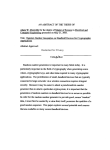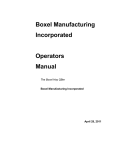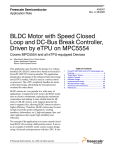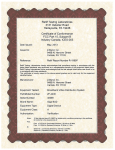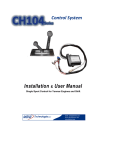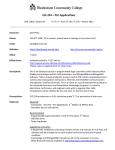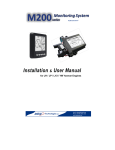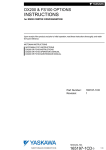Download PROTOTYPE TRAILER-LOADING ROBOT John J
Transcript
PROTOTYPE TRAILER-LOADING ROBOT John J. Ottersbach Robert L. Williams II Ohio University Athens, OH 45701 Final Finished Manuscript Version Industrial Robot: An International Journal December, 1999 Keywords: Pallet-loading robot, trailer-loading robot, autonomous pallet loading, semi-trailer loading dock automation Contact author information: Robert L. Williams II, Ph.D. Assistant Professor Department of Mechanical Engineering 257 Stocker Center Ohio University Athens, OH 45701-2979 phone: (740) 593 - 1096 fax: (740) 593 - 0476 email: [email protected] URL: http://www.ent.ohiou.edu/~bobw PROTOTYPE TRAILER-LOADING ROBOT John J. Ottersbach and Robert L. Williams II Department of Mechanical Engineering Ohio University [email protected] WORD COUNT: 4,102 KEYWORDS: Pallet-loading robot, trailer-loading robot, autonomous pallet loading, semi-trailer loading dock automation ABSTRACT The Pallet Handling Device (PHD) is a five degree-of-freedom (dof) robot system under development by Stewart-Glapat Corporation for autonomous loading of pallets into semi-truck trailers at loading docks. The fully-autonomous control is achieved using a programmable logic controller (PLC) and sensors. Ohio University has developed a one-eighth-scale prototype hardware system for PHD controls implementation and evaluation. This article describes the design and construction of this system, including the control architecture and PLC programming. The main objective of the scale hardware prototype is to demonstrate the autonomous control feasibility of the proposed full-scale PHD system; this cannot be adequately performed in simulation. 1. INTRODUCTION Large quantities of products and materials, stacked on pallets, are commonly transported in semitruck trailers. Today, the loading of such pallets into trailers is accomplished using 1920's technology, the forklift truck. A modern autonomous system has potential for saving money and improving quality and throughput. To answer this need, Stewart-Glapat Corporation of Zanesville OH is developing the Pallet Handling Device (PHD, patented by Stewart, 1995). The PHD concept is shown in Fig. 1. Ohio University has built a functioning one-eighth-scale 5-dof PHD prototype, supported by Stewart-Glapat Corporation. This article presents the design, construction, control, and evaluation of the PHD prototype for autonomous pallet loading. The primary objective of this project was to develop and demonstrate in hardware the PHD autonomous control feasibility using an industrial Programmable Logic Controller (PLC). Simulation of this process is not enough to demonstrate that this challenging autonomous control will actually work in the real world. Thus, building, programming, and testing prototype hardware is justified, primarily to attract future customers for further system development. Figure 1. Pallet Handling Device (PHD) Concept Robot systems for stacking products on pallets have been in use for some time. According to the recent literature, this subject is of current interest (Australian Meat Holdings, 1999; Motoman, 1999; FANUC Robotics, 1998; Hemmingson, 1998; Sorenti, 1996). The current article focuses on autonomously loading finished pallets into semi-truck trailers. No references were found for this. The current project originated with the patent by Stewart (1995). Other external resources for this project regarding design, control, sensors, and PLCs are now listed. Information on photoelectric and ultrasonic sensors for measurement tasks was obtained from Soloman (1994). Principles of operation and sensor characteristics for the ultrasonic and digital sensors were obtained from Areny and Webster (1991). Principles of operation and application of digital incremental encoders was obtained from Ruocco (1987). Application examples of PLC-type controllers and robotic drives used in industry for pick-and-place robots were obtained from Asfahl (1992). For background on the PLC and programming tips, Petruzella (1989) provided useful examples. Closed-loop controller design ideas were obtained from Dorf and Bishop (1998). Manufacturer information (such as motor data sheets) was obtained from Pittman (1992). The theory and application notes for the motor drivers are obtained from Servo Systems (1998). The theory of operation and specifications of ultrasonic sensors were obtained from Baumer Electric Company (1998). Specifications and operation of a photoelectric infrared (IR) distance sensor was obtained from the Aromat Company (1996). Allen-Bradley Inc. (1998) provided the programming references and instruction set for the PLC used. The significance of this project is in assisting Stewart-Glapat engineers to bring this PHD concept to the industrial marketplace; the PHD has great potential to save loading costs by eliminating forklift trucks and their human operators at loading docks where there is high volume and consistently-sized pallets. 2. PROTOTYPE DESIGN AND CONSTRUCTION The objective of the prototype PHD hardware is to fully demonstrate autonomous pallet loading. Insofar as possible, the scale hardware should incorporate the same sensors and controller as the future full-size hardware. The scale hardware should be portable and fit on a standard tabletop for demonstrations. No load need be carried (other than scale pallets), but the controller must have all required functions. A single prismatic joint may be used in place of the telescoping prismatic joint in the full-size design. Also, no roller conveyor is required for the prototype; pallets will be loaded by hand. A movable scale trailer is required to demonstrate autonomous loading at different trailer locations and orientations. A one-eighth-scale prototype is chosen, based on standard table dimensions. The exact scale was increased to 1:7.7 to accommodate real world devices such as the sensors, which cannot be scaled down in the prototype. This article summarizes PHD prototype design, control, and results. For more details, see Ottersbach (1999). While the article focuses on the prototype hardware, the full-scale hardware will be built with the same technology insofar as possible. 2.1 PHD System Description The PHD concept of Fig. 1 is comprised of a large telescoping arm that supports a 4-axis PHD assembly. This assembly has the freedom to rotate a pallet by 180 and manipulate it both horizontally and vertically. This device is a 5-dof serial robot with 4 prismatic joints and 1 rotary joint, as shown in Fig. 2. We now describe the PHD autonomous loading procedure. A pre-loaded pallet is delivered by some means (such as a roller conveyor) along the back of the telescoping section to the pallet waiting position. A trailer is parked at the loading dock within established limits. The PHD supervisor makes a visual inspection to ensure the trailer is empty. The PHD is then activated for autonomous loading. Top View Trailer Axis 1 Axis 1 Displacement Axis 2 Trailer Side View Axis 2 Displacement Axis 2 Axis 3 Top View Trailer Axis 3 Top View Axis 3 Displacement Axis 4 Displacement + Axis 4 Axis 5 Trailer Side View Axis 5 Displacement Axis 5 Figure 2. PHD Joint Freedoms The unloaded PHD extends into the trailer, actively measuring the width, height and length dimensions using non-contact sensors. The measurement scans determine the trailer size and orientation, which are used to determine if the trailer can be loaded. The system determines the number of pallets (based on a pre-programmed pallet size) that will fit and where to place them. If the trailer is offset too far, the PHD retracts and alerts the supervisor. The trailer then needs to be re-parked and operations restarted. With the measurement of the trailer complete, the PHD returns to pick up the waiting pallet. The telescoping arm retracts so that it is near the pallet. A mechanical brake is released to allow the pallet to roll onto the forks until it makes contact with the back of the forks. The contact closes a bump- bar switch indicating that the pallet is engaged. The forks raise the pallet off the rollers, bearing the full weight of the load. The PHD rotates the fork assembly 180 so that the pallet is facing the trailer. The forks lower to a safe position near the floor for translation into the trailer. The telescoping section extends to the desired row position and the PHD assembly is lowered to a point near the floor. The PHD side-shifts the pallet either left or right to the desired pallet position. The forks lower the pallet to the floor of the trailer and passively tilt down near the floor for unloading. Finally, the PHD retracts and returns to pickup another pallet for loading. This process repeats until the trailer is loaded. 2.2 Actuators and Sensors 2.2.1 Actuators. The 5-dof serial robot has prismatic actuators for joints 1, 2, 3, and 5 and a rotary joint actuator for joint 4. Joint 1 serves the telescoping function into the trailer, with a simplified design for the prototype. A rack and pinion drive is used, as shown in Fig. 3. The link is supported by linear bearing guides in which the bearing blocks slide freely to provide the motion. The bearing blocks are fixed to the surrounding support structure. Power from the DC servo gearmotor is transferred through a pinion gear to a rack gear, which is mounted to the base of the link. Side View Mounting Holes for PHD Assembly Axis 1 Link Linear Bearing Block Gear Rack Pinion Gear Bearing Guide Mounting Holes DC Servo Gear Motor Linear Motion Figure 3. Prismatic Joint 1 Design Prismatic joints 2, 3, and 5 are actuated using the same lead screw design (shown in Fig. 4) wherein the rotary motion of a DC servomotor is converted to linear motion. The stainless steel lead screw is driven through a gear train coupled to a DC servomotor. The screw turns inside a nut machined from Delrin plastic and is simply supported on both ends using bearings. The nut transfers linear motion to the next link that is supported on the guide rails using Delrin slide blocks. Side View Linear Motion Guide Rail Guide Block (Delrin) End Block Bearing Spur Gear DC Servo Motor Lead Screw Lead Screw Nut (Delrin) Spur Gear End View Guide Block Rotation DC Servo Motor Figure 4. Prismatic Joints 2, 3, 5 Design Joint 4 is the rotary actuator that enables the forks to rotate 180 to pick up a pallet from its waiting position and rotate back for pallet positioning inside the trailer. This axis makes use of a spur gear mounted on top of a bearing for the rotary motion, as shown in Fig. 5. The bearing is required to support both an axial load and a moment created from the overhung load of the pallet and fork assembly. For the scale model, a small 'Lazy Susan' bearing is used. Figure 6 shows the prototype PHD. Figure 7 shows the prototype extending into the trailer. DC Servo Motor Side View Spur Gear Lazy Susan Bearing Rotary Motion Spur Gear Motor Mount Top View Mounting Holes Figure 5. Rotary Joint 4 Design Figure 6. Prototype PHD Hardware Figure 7. Prototype PHD Hardware with Trailer 2.2.2 Sensors. The PHD prototype contains a variety of analog and digital sensors for position control and workspace measurement. Shaft-mounted digital encoders are used for closed-loop position control of axes 2-5. These sensors mount to the motor shaft and provide a series of digital pulses whereby the number of motor shaft revolutions can be determined. The encoders are of incremental, quadrature type with a differential output and index pulse. The resolution (i.e. the smallest unit of movement detected by the sensor) on the encoder code wheel is 500 counts/rev (CPR). Using a 4x detection circuit, the resolution becomes 2000 CPR. This value, together with the known gear ratio and screw lead can be used to control the position of the PHD axes 2-5. Axis 1 uses an analog position feedback sensor instead of a digital encoder. One design specification specifically stated that an encoder not be used for this axis. Due to telescoping chain drive slop and tip deflection in the full-size fully-loaded PHD, a digital encoder will not accurately report the actual position of the PHD. Therefore, an improved method is to use a sensor that measures absolutely the distance the PHD has extended into the trailer. For the scale prototype, a photoelectric analog sensor is used, mounted to the axis 1 fixed section. A diffuse-type infrared (IR) light beam is emitted from the sensor and strikes a white paper reflector surface, mounted to the back of the PHD assembly. This sensor determines the distance using a triangulation technique (Aromat Corp., 1996) and returns an analog (1-10 VDC) signal depending upon the distance. This sensor resolution is about 3.0 mm. The remaining position control sensors are the limit switches located at the end of travel points on each axis. These switches are normally open (NO) and when axis motion closes one of these switches, the motion can be stopped or reversed for safety. For measurement of the trailer workspace, a system of analog ultrasonic sensors is used. Each provides an analog signal (0-10 VDC) based on the distance to the trailer walls. There is one sensor for each dimension of the trailer: up, down, left, right and forward (see Fig. 8). Ultrasonic sensors are used because of their known reliability, repeatability, and linearity. The sensors emit a pulse of ultrasonic waves and, based on the time of flight for the pulse to strike the target and return, an analog voltage is produced (Baumer Electric Company, 1998). The target must be non-porous, flat, and roughly perpendicular to the sensor's emitter or the pulse may be absorbed, or deflected away. The trailer walls make good targets because they are generally lined with flat sheets of plywood, steel, or fiberglass and the walls are straight along the length of the trailer. Depending upon the skew angle at which the trailer is parked, the perpendicular requirement may or may not be met. However, the sensors have an 8 allowance for skewed targets which is greater than the allowable skew based on trailer parking design specifications. The ultrasonic sensors have a resolution of 0.3 mm. Since ultrasonic sensors depend on the speed of sound in air, factors such as temperature can influence the sensor’s accuracy. Therefore, the ultrasonic sensors used in this project incorporate a built-in thermocouple sensor to account for this. The final issue regarding the ultrasonic sensors is the fact that they are located in close proximity to each other. The sensors can be affected by the emitting pulse from a neighboring sensor or by echo conditions inside the enclosed trailer. Therefore, the five sensors are enabled one at a time (sequentially, continuously). Top View Up Left Ultrasonic Sensor Forward Down Trailer Right Figure 8. Ultrasonic Sensor Layout 2.3 Control Hardware In the design specifications, an industrial programmable logic controller (PLC) was required to control the autonomous loading process. The controller system consists of the PLC, power supplies, motor drivers and an interface for the user and the robot sensors and actuators. All major components reside in a controller chassis, shown in Fig. 9. The user interface is on the top of this chassis, see Fig. 10. The user interface includes operational and mode buttons, manual joint control switches, error lights, and E-stop. Figure 9. PHD Controller Chassis Figure 10. PHD User Interface A PLC is modular in design with light emitting diode (LED) fault status indicators on each module. Each module represents a specific type of input or output (I/O). If one of these modules fail, a new module can be inserted, even under power, to replace the faulty one. PLCs are programmed using ladder logic, which is designed for ease of use, troubleshooting and debugging. PLCs interface easily to real world devices such as switches, analog and digital sensors, and motor drives. The prototype uses simple sequential motion steps for demonstration of its autonomous loading capabilities. The function of the PLC is to evaluate the inputs from the sensors and provide the required outputs for autonomous pallet loading. The PLC is an Allen-Bradley ControlLogix 5550 model. This model is chosen because of the servo card modules that it uses for closed-loop position and velocity control for servomotors fitted with a digital encoder. The servo modules in this model incorporate a high-speed encoder counter and an analog output for control of two axes per module. The software provides a library of 27 motion commands for easy motion integration into the typical PLC ladder logic program (Allen Bradley, 1998). The system layout is given in Fig. 11. The PLC consists of a chassis, power supply, a processor and various I/O modules. The modules fit into slots on the PLC chassis and communicate to the processor through a bus located on the back of the chassis. A PC is used to develop and edit the ladder logic program that is downloaded through the serial port to the PLC processor module located in slot 0 of the PLC chassis. This interface can be removed and the PLC then functions as a standalone controller. However, if left connected, the PC also functions as a monitoring station. Various I/O can be viewed to assist with troubleshooting or program editing while the controller is running. The programming terminal requires the Windows NT version 4.0 operating system. PC Programming Terminal Power Supply + - + Serial Port Interface PLC PLC Power Supply 24 VDC 5 VDC 0 1 2 3 4 5 6 (Slot) Module Type (0) Processor (1) Servo Card Axis 2 & 3 (2) Servo Card Axis 4 & 5 (3) Analog Output (4) Analog Input (5) Digital Output (6) Digital Input Space for Expansion Limit & Control Switches LED Indicators Ultrasonic Sensors (0-10 V) (1-10 V) IR Sensor (+/- 10 VDC) PWM Servo Amp. DC Motor Axis 1 (+/- 10 VDC) PWM Servo Amp. DC Motor & Encoder Axis 5 Encoder Feedback (+/- 10 VDC) PWM Servo Amp. DC Motor & Encoder Axis 2 Encoder Feedback Figure 11. PHD Control Layout - + - 3. PHD CONTROL ARCHITECTURE This section summarizes the PHD control architecture developed for the prototype hardware; it also applies to the future full-size hardware. This includes automatic data acquisition and manipulation, autonomous homing, autonomous loading, and manual control for error recovery. 3.1 PHD Controls Description The function of this robot is to automatically load two pallets per row for the length of the trailer. The trailer may be parked offset or at a skewed angle, and different-sized trailers must be accommodated. This requires acquiring new data using the sensors and manipulating this data to determine the width, height, length and orientation of the trailer for each new empty trailer. The robot must also use this data to determine where to place each pallet. Only four values are pre-programmed into the PLC, pallet width, length, row spacing, and the distance between the robot and the dock door. 3.2 Individual Axis Control This subsection describes independent PHD joint control for the prototype. First, the feedback sensors (infrared for axis 1 and ultrasonic for joints 2-5) must be calibrated as in Ottersbach (1999). The feedback control diagram for axis 1 control is shown in Fig. 12. Controller Chassis Software Routine Desired Position Error + P PLC Analog Output Module PWM Servo Amp. - Actual Position 20-80 cm Calibration Function PLC Analog Input Module 1-10 VDC Figure 12. Axis 1 Control Block Diagram Robot DC Motor Axis 1 IR Sensor The rack-and-pinion DC motor is actuated via a simple proportional controller (where the P gain is determined experimentally), based on length feedback from the IR sensor. The control of PHD axes 2-5 is done using the closed-loop servo modules and the library of motion commands available in the ladder logic software (Allen-Bradley, 1998). The servo modules are first configured for closed-loop operation using the setup procedures. During the setup, the servo modules automatically determine the location of the marker pulse on the encoder, the proportional and integral (PI) gains for the controller, and the direction of positive rotation of the motor shaft. After setup, the modules are ready to accept instructions such as motion-axis-move (MAM), motion-axis-jog (MAJ), motion-axis-home (MAH) and motion-axis-stop (MAS). 3.3 Autonomous Mode Autonomous loading of pallets into the trailer consists of automatic homing of the PHD, a fivestep auto-scan for measuring the trailer workspace, and a twelve-step process for autonomously loading the pallets. See Ottersbach (1999) for details. 4. RESULTS 4.1 Individual Axis Control Results The performance of the closed-loop position controller for axis 1 is now presented. Since the axis 1 motor is not equipped with an encoder, the PLC servo modules with their predefined controllers and library of motion commands cannot be used. The controller results are obtained by commanding axis 1 to extend from 20.3 cm (the home position), to 45.7 cm (the nominal row 2 position). From the results, the percent overshoot, settling time and steady-state error are determined. The P gain is chosen empirically to obtain the desired performance. Position overshoot is not desired since this may lead to collisions. Also, steady-state error should be low for good pallet placement results. P=1.8 is the best value found, and its results are shown in Fig. 13. Axis 1 Extension (cm) 50 40 30 20 10 0 0 1 Time (sec) 2 3 Figure 13. Axis 1 Closed-Loop Control Results The results of the position control of axis 2 on the PHD assembly are presented as an example to demonstrate the good properties of an encoder-equipped motor. Here the motor is controlled by the servo module and motion commands available from the PLC programming software. The performances for the other axes (3-5) on the PHD assembly are similar and therefore only axis 2 is presented. The results are obtained in the same way as for Fig. 13. However, the desired position is specified in terms of motor revolutions and not a commanded length. This position is 33 revolutions from the home position, at 50% maximum speed and acceleration, following a trapezoidal input. This position is selected because it is the desired position for axis 2 to raise to during both the auto-scan and auto-load sequences. As shown in Fig. 14, the desired position of 33 revolutions is achieved. In terms of linear distance this is a move of 29.4 mm. From the results, the overshoot is 0.0 %, the settling time is 2.7 seconds and the steady-state error is 0.05 %, or 0.015 revolutions (0.01 mm). This plot should not be compared to axis 1 which has different dynamics. While Figs. 13 and 14 apply to the prototype, they are included because the same controls technology will be used in the full-scale hardware. Motor Angular Displacement (Rev) 35 30 25 20 15 10 5 0 0 0.5 1 1.5 2 2.5 3 3.5 4 Time (sec) Figure 14. Axis 2 Closed-Loop Control Results 4.2 Pallet Placement Results The prototype hardware was able to load pallets into the scale trailer autonomously with good repeatability and accuracy, even in the face of intentional errors such as trailer offset (horizontal and vertical) and trailer skew angles (tilting down away from and yawed with respect to the loading dock). For a detailed uncertainty analysis regarding pallet placement, please see Ottersbach (1999). Figure 15 shows a top view of the prototype system loading pallets autonomously into the scale trailer. Holes were cut into the pallets to reduce weight. Typical pallet spacing results, within acceptable parameters, are shown. Figure 15. Pallet Loading Top View Figure 16 shows typical actual pallet placement results, for a right yaw-skewed trailer. Note that the pallets were placed in a stepped fashion, i.e. still normal to the loading dock despite the trailer yaw. The auto-scan correctly maps the workspace and maintains proper clearance at all rows. In order to place pallets parallel to a yawed trailer, coordinated control of the axes is required. This has not yet been implemented. 2.1° 18.3 mm 12.7 mm 9.6 mm 10.4 mm 16.0 mm 9.6 mm 16.0 mm 11.9 mm 14.2 mm 13.5 mm 12.7 mm 11.9 mm Figure 16. Yawed Trailer Pallet Placement Results 4.3 Design Recommendations While the above results prove the PHD concept to be feasible in hardware, lessons learned in the scale prototype will improve the full-size hardware design. The weakest part of the prototype was the IR sensor for axis 1 feedback control. In the full-size hardware a laser sensor should be used instead. Also, a combined encoder/laser feedback could be used for improved axis 1 control. Implementing PI control instead of P only for axis 1 should reduce the steady-state error that was sometimes significant. Coordinated joint control should be implemented so the pallets may be placed parallel to the walls of a skewed trailer. Pallet height was ignored in this project, but should be measured in the final system. Full safety measures and error recovery procedures are crucial to success and need to be fully developed. To date, the inclusion of manual control mode is the only activity in this area. Reliability needs to be a high priority in design; the prototype displays high reliability, but it was not designed as such. On the full-size hardware there will be more room for additional sensors; another down-looking ultrasonic sensor may be added to determine trailer roll angle which has been ignored to date. A single ultrasonic sensor may be added near the forks to detect any pallet shifting during loading. Along with these recommendations, all existing prototype features should be incorporated in the full-size hardware insofar as possible. 5. CONCLUSION This article presents the design and control of scale prototype Pallet Handling Device (PHD) hardware for autonomous loading of pallets into semi-truck trailers. This project was successful in demonstrating that autonomous loading is feasible using sensor feedback and a PLC. Simulation alone is not sufficient to prove that the concept will function as required in reality. Design lessons learned will be reflected in the full-size system design. While much of the focus in this article is on the prototype hardware, most of the technology described will be used directly in the full-scale hardware in the future. Such a system has great potential to save shipping costs by automating loading docks where there is a high volume of consistently-sized pallets. The current project focused only on pallet loading. The autonomous unloading of pallets is more challenging due to over-the-road pallet shifting and will be addressed in prototype hardware in the future. ACKNOWLEDGEMENTS Ohio University gratefully acknowledges Stewart-Glapat Corporation for the project idea and funding. We also appreciate Stewart-Glapat Corporation's assistance in procurement, machining, and technical expertise. REFERENCES Allen-Bradley Inc., 1998, ControlLogix Motion Module User Manual, Pub. 1756-6.5.16, Milwaukee, WI, http://www.ab.com. R.P. Areny and J.G. Webster, 1991, Sensors and Signal Conditioning, New York: John Wiley. Aromat Corporation, 1996, Sensor Catalog, New Providence, NJ. C.R. Asfahl, 1992, Robots and Manufacturing Automation, New York: John Wiley and Sons. Australian Meat Holdings, 1999, "Robot First for Palletising Beef in an Abattoir", Industrial Robot: An International Journal, 26(4): 298. Baumer Electric Co., 1998, Precision Sensor Catalog, Southington, CT. R.C. Dorf and R.H. Bishop, 1998, Modern Control Systems, Reading, Mass.: Addison-Wesley. FANUC Robotics, 1998, "Two Versions of Palletising Robot Unveiled", Industrial Robot: An International Journal, 25(5): 354-5. E. Hemmingson, 1998, "Palletizing Robots for the Consumer Goods Industry", Industrial Robot: An International Journal, 25(6): 384-388. Motoman, 1999, "Motoman's Modular, Pre-engineered PalletWorld", Industrial Robot: An International Journal, 26(3): 225-6. J.J. Ottersbach, 1999, Controls Development for the Pallet Handling Device, MS Thesis, Ohio U. F.D. Petruzella, 1989, Programmable Logic Controllers, New York: McGraw-Hill. Pittman Co., 1992, DC Permanent Magnet Field Motors and Gearmotors, Harleysville, PA, http://www.pittmannet.com. S.R. Ruocco, 1987, Robot Sensors and Transducers, New York: John Wiley and Sons. Servo Systems Co., 1998, Engineering and Application Notes, Montville, NJ. S. Soloman, 1994, Sensors and Control Systems in Manufacturing, New York: McGraw-Hill. P. Sorenti, 1996, "Rapid Palletizing: Simulation in the Fast Lane", Industrial Robot: An International Journal, 23(3): 16-19. W.T. Stewart, 1995, Pallet Handling Adjustable Conveyor, U.S. Patent Number 5,391,038, http://www.adjustoveyor.com.























